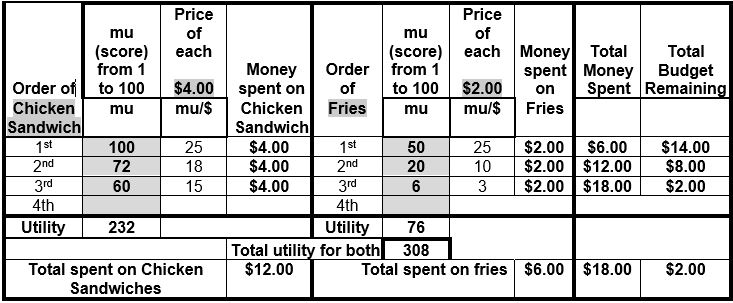Question
Hi, I asked this question yesterday, but I thought one or more of the suggested answers were incorrect, so I replied beck to that question
Hi,
I asked this question yesterday, but I thought one or more of the suggested answers were incorrect, so I replied beck to that question string and for some reason my question got canceled. I'll just try again and compare the new response with what I thought was incorrect on yesterday's tutor response. Thanks so much for the help!
focus on marginal utility, Price Elasticity of Demand, and understanding the difference between Price Elasticity of Demand and Income Elasticity of Demand.
We all subconsciously assign "scores" to what we are considering to purchase, based on our expected level of "satisfaction" (Marginal Utility) with that purchase. When making simultaneous pairs of purchases, again we subconsciously compare the amount of "satisfaction" (Marginal Utility) that we will receive from the pair of purchases. To decide on the "ideal" combination of these two purchases, we expect that the last dollar we spend on each of the items will give us the "same" satisfaction per dollar (Marginal Utility per dollar). Further, we know that the MORE of an item that we get, the next one we get will give us LESS "satisfaction" (Marginal Utility) than the last one gave us (the Law of Diminishing Marginal Utility). Using what you have learned about Marginal Utility and Marginal Utility per dollar, answer the following questions.
Questions
1. Jane has been working all day, missing both her breakfast and lunch. Finally able to leave work, after being required to work a couple of overtime hours, she is starving. Jane has $20 in her pocket, so she stops at a local fast food restaurant and orders a grilled chicken sandwich and an order of fries. As she sits down to eat them, a University student approaches her and tells her that she is doing a research project for her microeconomics course, and would like to ask Jane a few quick questions. Jane agrees and the student asks what "score" (marginal utility) from 1 to 100 would she give as her satisfaction level with the 1st sandwich and the 1st fries? After eating that order, Jane is still hungry and orders a second chicken sandwich and another order of fries. Again, the student asks Jane to give her new scores. Since Jane has not eaten all day, she is hungry enough to order a third round of food and again gives "scores" to the inquisitive student.
Below is the University student's completed experiment tally sheet of Jane's marginal utility "scores" and the calculation of her marginal utility per dollar, given that each sandwich costs $4.00, and each order of fries costs $2.00. Her budget is $20.
The student filled in the shaded cells based on Jane's responses, then computed the values in the remaining cells. Using this information, answer the following questions:
Student's completed experiment tally sheet. Available budget is $20.



Step by Step Solution
There are 3 Steps involved in it
Step: 1

Get Instant Access to Expert-Tailored Solutions
See step-by-step solutions with expert insights and AI powered tools for academic success
Step: 2

Step: 3

Ace Your Homework with AI
Get the answers you need in no time with our AI-driven, step-by-step assistance
Get Started


